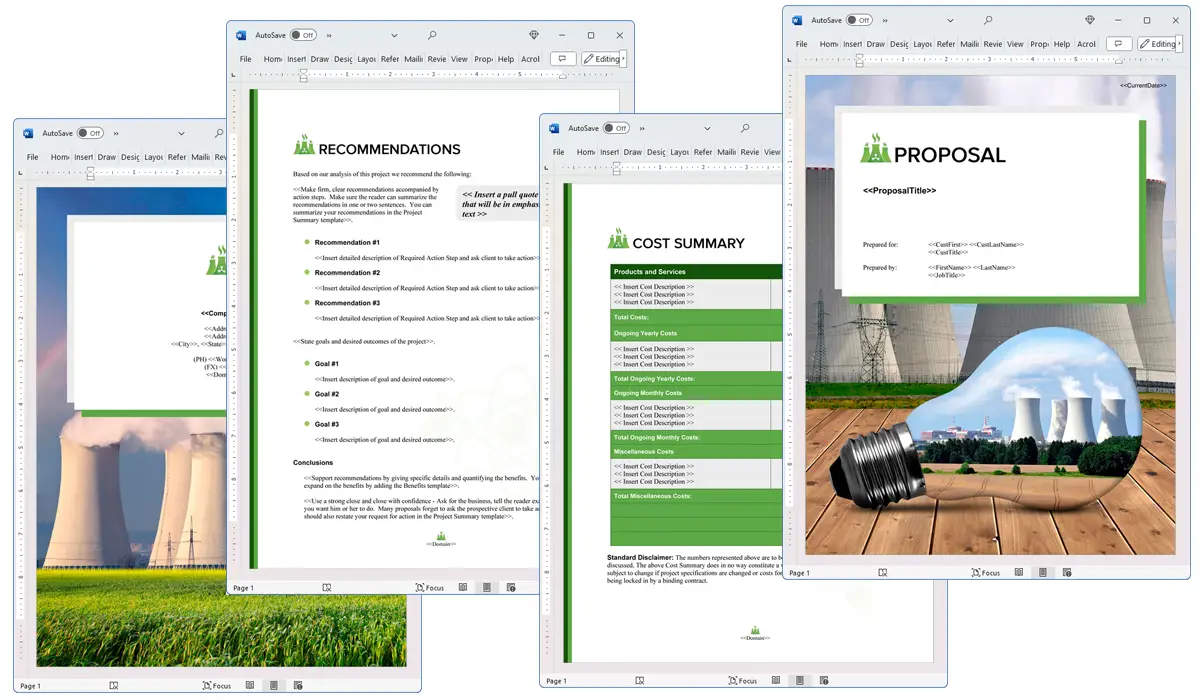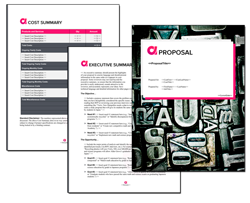What is the Environmental Protection chapter used for?
Proposal Kit Professional Bundle adds more design themes, all six Contract Packs,
a project management library, and Expert Edition software.

Illustration of Proposal Pack Energy #11
We include this Environmental Protection chapter template in every Proposal Pack, along with thousands more. You assemble this chapter with others in various combinations to create custom-tailored business proposals, plans, reports, and other documents. Proposal Packs apply custom visual designs to the templates, giving the final documents a consistent professional finish.
 DOWNLOADABLE, ONE-TIME COST, NO SUBSCRIPTION FEES
DOWNLOADABLE, ONE-TIME COST, NO SUBSCRIPTION FEES
Overview of the Environmental Protection Chapter
The Environmental Protection chapter is an important component used in creating a proposal document. It plays a significant role in highlighting the commitment of a business or organization to sustaining environmental health and integrity. This chapter is tailored to underline the importance of environmental stewardship withconsidering the situation of the proposed project or activity. It serves as a persuasive and informational tool to demonstrate to stakeholders and decision-makers the proactive measures taken to address environmental concerns linked to the project.
How is the Environmental Protection Chapter Used?
When used in a business proposal, the Environmental Protection chapter is used to describe the environmental implications of a proposed project and the strategies to manage or mitigate negative impacts. This chapter is instrumental in building trust and credibility with clients and funding bodies by showcasing the organization's dedication to environmental responsibility. It helps in framing the proposal in a manner that aligns with regulatory requirements and ecological sustainability, making the project more appealing and viable from an environmental perspective.
What is Included in the Environmental Protection Chapter?
The Environmental Protection chapter typically includes several key elements:
- Identification of Environmental Issues: This section outlines specific environmental challenges that the project might exacerbate or help mitigate.
- Regulatory Compliance: Details related to adherence to local, national, or international environmental laws and regulations.
- Impact Assessment: A thorough analysis of the potential environmental impacts of the project.
- Mitigation Strategies: Solutions and strategies to reduce negative environmental impacts.
- Sustainability Measures: Initiatives or practices that contribute to long-term environmental sustainability.
Use Case Examples for the Environmental Protection Chapter
The Environmental Protection chapter can be used in various industries and contexts within proposal documents, such as:
- Environmental Proposals: For projects specifically focused on ecological conservation or restoration.
- Green Initiatives: Proposals aimed at promoting sustainable practices in businesses or communities.
- Nature Conservation: In proposals seeking to protect natural habitats and biodiversity.
- Energy Projects: Particularly for renewable energy projects that emphasize minimizing environmental footprints.
- Resource Management: For managing natural resources in a sustainable manner.
- Mining Operations: Proposals that outline responsible mining practices to mitigate environmental damage.
- Government Contracts: When addressing government projects that require stringent environmental safeguards.
- Research and Science Projects: In proposals for research aimed at environmental protection or ecological studies.
- Concept Development: For innovative concepts that include environmental sustainability as a core component.
Key Takeaways
- Focus on Sustainability: The Environmental Protection chapter is important for showcasing a project's alignment with environmental sustainability.
- Regulatory Compliance: It helps ensure that the proposal meets all necessary environmental regulations and standards.
- Mitigation of Negative Impacts: The chapter outlines strategies to minimize environmental impacts associated with the project.
- Enhancing Credibility: Including this chapter can significantly boost the trust and confidence of stakeholders and decision-makers in the project.
- Versatility Across Industries: This chapter is applicable in a myriad of industries and types of proposals, emphasizing its universal relevance and necessity.

Illustration of Proposal Pack Symbols #9
 What Our Clients Say
What Our Clients SayI thought Proposal Pack was as good as it gets - until... I use Proposal Pack Wizard on a daily and it truly multiplies the time savings already realized in the regular Proposal Pack. My company thinks that I am a proposal creating machine! Little do they know that I work far less hours now than at any other time in my life and get 10 times the work done. If you want to fully understand the phrase, "Work smarter - not harder" then purchase Proposal Pack Wizard to accompany whichever version of Proposal Pack you choose - and work half as much for twice the reward."
 4.7 stars, based on 845 reviews
4.7 stars, based on 845 reviewsRelated Chapters

The Environmental Protection chapter and other chapters are integrated into a Word document as illustrated here in the Proposal Pack Catering #2 design theme. There are hundreds of design themes available, and every design theme includes the Environmental Protection chapter template.
A proper business proposal will include multiple chapters. This chapter is just one of many you can build into your proposal. We include the complete fill-in-the-blank template in our Proposal Pack template collections. We also include a library of sample proposals illustrating how companies in different industries, both large and small, have written proposals using our Proposal Packs. This template will show you how to write the Environmental Protection.
We include a chapter library for you to build from based on your needs. All proposals are different and have different needs and goals. Pick the chapters from our collection and organize them as needed for your proposal.
Using the Proposal Pack template library, you can create any business proposal, report, study, plan, or document.
 Ian Lauder has been helping businesses write their proposals and contracts for two decades. Ian is the owner and founder of Proposal Kit, one of the original sources of business proposal and contract software products started in 1997.
Ian Lauder has been helping businesses write their proposals and contracts for two decades. Ian is the owner and founder of Proposal Kit, one of the original sources of business proposal and contract software products started in 1997.By Ian Lauder
 Published by Proposal Kit, Inc.
Published by Proposal Kit, Inc.


 Cart
Cart
 Facebook
Facebook YouTube
YouTube X
X Search Site
Search Site